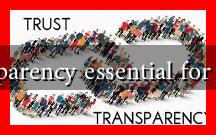-
Table of Contents
Is Fostering Transparency Essential for Maintaining Trust?
In an era where information is readily available and skepticism is rampant, fostering transparency has become a cornerstone for building and maintaining trust. Whether in personal relationships, corporate environments, or governmental institutions, transparency plays a pivotal role in how trust is established and sustained. This article delves into the significance of transparency, its impact on trust, and real-world examples that illustrate its importance.
The Importance of Transparency
Transparency refers to the openness and clarity with which information is shared. It involves being honest about processes, decisions, and outcomes. The importance of transparency can be summarized in the following points:
- Builds Credibility: Organizations that are transparent are often viewed as more credible. When stakeholders have access to information, they are more likely to trust the intentions behind decisions.
- Encourages Accountability: Transparency holds individuals and organizations accountable for their actions. When people know they are being observed, they are more likely to act responsibly.
- Enhances Communication: Open communication fosters a culture of trust. When information flows freely, misunderstandings are minimized, and relationships are strengthened.
- Promotes Engagement: Stakeholders who feel informed are more likely to engage with an organization. This engagement can lead to increased loyalty and support.
Transparency in Business
In the business world, transparency is crucial for maintaining customer trust and loyalty. Companies that prioritize transparency often see positive outcomes. For instance, a study by the Harvard Business Review found that organizations that practice transparency experience higher employee satisfaction and lower turnover rates.
One notable example is Patagonia, an outdoor clothing company known for its commitment to environmental sustainability. Patagonia openly shares its supply chain practices, including the sourcing of materials and labor conditions. This transparency has not only built trust with consumers but has also positioned the brand as a leader in corporate responsibility.
Transparency in Government
In the realm of governance, transparency is vital for democratic processes. Citizens need access to information about government actions to hold officials accountable. The Transparency International Corruption Perceptions Index highlights the correlation between transparency and reduced corruption levels. Countries that embrace transparency often rank higher on this index, indicating a lower perception of corruption.
For example, New Zealand consistently ranks as one of the least corrupt countries in the world. Its government practices transparency through open data initiatives, allowing citizens to access information about public spending and decision-making processes. This openness fosters trust in government institutions and encourages civic engagement.
The Risks of Lack of Transparency
Conversely, a lack of transparency can lead to distrust and skepticism. When organizations or governments withhold information, it raises suspicions and can damage relationships. Some potential risks include:
- Loss of Credibility: Organizations that are not transparent may be perceived as hiding something, leading to a loss of credibility.
- Increased Scrutiny: Lack of transparency often invites external scrutiny, as stakeholders demand answers and explanations.
- Decreased Loyalty: Customers and employees may disengage from organizations that do not prioritize transparency, leading to decreased loyalty and support.
Conclusion
In conclusion, fostering transparency is essential for maintaining trust across various domains, including business and government. Transparency builds credibility, encourages accountability, enhances communication, and promotes engagement. Organizations like Patagonia and countries like New Zealand exemplify how transparency can lead to positive outcomes and increased trust. Conversely, the risks associated with a lack of transparency can lead to distrust and disengagement. As we navigate an increasingly complex world, prioritizing transparency will be crucial for building and sustaining trust in our relationships, organizations, and institutions.

